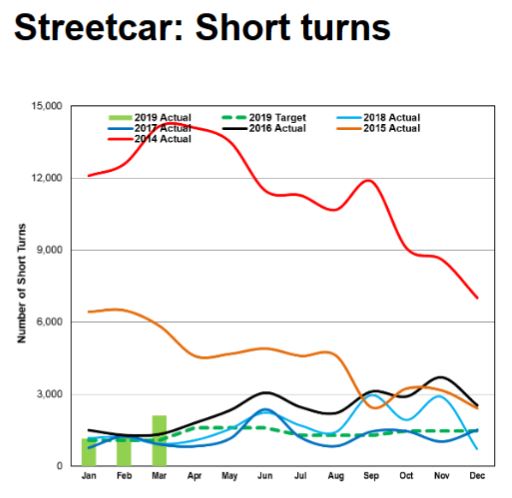A recent report by the CBC on May 8 claimed that the “transition to new streetcars will help alleviate short turns on major routes”. TTC spokesman Stuart Green, citing the May 2019 CEO’s Report, said that a large increase in short turns during March 2019 was caused by, among other things, the mix of new and old cars on the route with the strong implication that things will be better once Queen goes 100% low-floor in late June.
The CEO’s Report cites various factors:
Over the five-week period, the 501 Queen route made up approximately 40% of all short turns. This increase on the 501 route was due to several factors:
First, the reduction in Run-As-Directed (RAD) streetcars beginning in Week 8 (from 6 a.m./p.m. to 3 a.m./p.m.) has hurt the operational flexibility to respond to incidents and service gaps on all routes.
Second, the Queen route is largely serviced by CLRVs. These legacy vehicles experienced a high number of mechanical delays and disablements in March.
Finally, the Queen route is in a transition period with LFLRVs making up a small portion of the vehicles on the route, mixing with the CLRVs that have historically operated on the route. The different speed and operating characteristics of the two vehicle types inherently leads to more bunching and gapping on the route. [p 37]
The situation on Queen is even more complex than this and includes factors not listed in the CEO’s report:
- Weather varied substantially over the winter months and yet short turns were at a substantially lower level in January and February.
- Many delays on streetcar routes were caused by the City of Toronto’s failure to clear snow resulting in many cars parking foul of the tracks.
- There is a persistent problem with uneven headways (bunching and gapping) leaving terminals, and little evidence of attempts to evenly space service. The mix of vehicle types can compound this problem depending on the capacity of the “gap car”.
From a rider’s point of view, irregular service and short turns may be indistinguishable especially for someone beyond a common short-turn location. On the east end of Queen, this is Woodbine Loop. It does not matter whether a 20 minute gap to Neville is caused by a short-turn at Woodbine, or because the service is running in packs separated by long gaps. In practice, most of the scheduled service does reach Neville, but it neither arrives nor leaves on a reliable headway (the time between cars).
At the May 8 TTC Board Meeting, Acting CEO Kirsten Watson noted that there had been a change in operational strategy in April whereby operators who were “late” to the schedule short-turned by trading vehicles with another car near a terminal rather than physically short-turning their own car. The result is that the operator gets back on time while their original car continues to the terminal.

